The works of the artist trio Haerizadeh, Haerizadeh and Rahmanian are full of symbols and stories. The renowned author and professor Laura Marks on their hidden meanings and how to use joy as a political weapon.
If current Iranian culture is joyless and stifling, and artists living in that country must contort themselves in order to express creativity without inviting censorship, then living in self-imposed exile allows Ramin Haerizadeh, Rokni Haerizadeh, and Hesam Rahmanian to plunder Persian Iranian cultural history and irreverently recombine it with whatever they fancy. Doing so, the trio are able to nurture creative and political gestures arisen from within their abandoned home country and release ancient powers, generating exuberant and unsettling new forms of life.
The exhibition at the Schirn, transplanted from the artists’ home studio in Dubai, invites one to fantasize about living within one’s own work of art—sort of a cross between the obsessive, allover Dadaism of Kurt Schwitters’ “Merzbau” and a campy home-design catalogue. It invites us to imagine the life the three artists have constructed for themselves in exile, celebrating sensuous pleasures and private jokes, as though they are thumbing their nose at the Islamic Republic.
Raucously playful improvised assemblages, the allover painted floor; colors, colors everywhere. In their video “From March to April…2020”, the voices we hear, monotonously pronouncing the days of the week, evoke the claustrophobia of lockdown; but the images give a glimpse of the artists’ dedication to a good life of art making, study, aesthetic pleasure, and delicious food. Day after day, the camera pans down a long table crowded with paints, works in progress, books and papers, and set on top of them, mouth-watering meals, different every time.
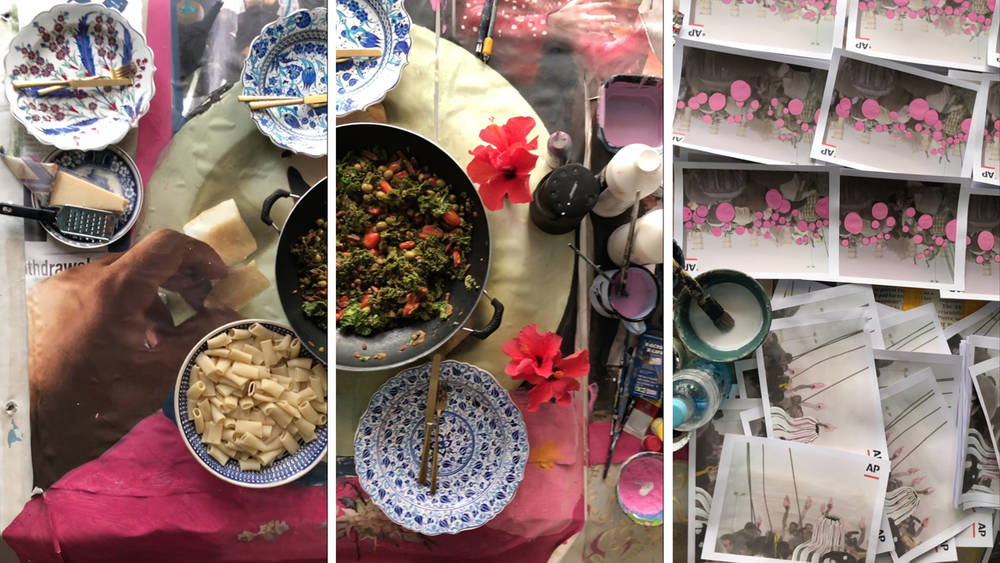
The creative pleasures of exile steal back into Iran by clandestine routes, as we learn most delightfully from “Dance after the Revolution”. Clearly the artists model themselves on the defiant and infectious creativity of dancer Mohammad Khordadian, who reestablished himself, like so many Iranians fleeing the Islamic revolution of 1979, in Los Angeles. There Khordadian hybridized a slew of now-forbidden Persian musical traditions, from 1920s cabaret to folk dance, with American aerobics, and it is delightful to see his troupe working out in sweatbands and legwarmers. In a revolutionary development, Khordadian grafted women’s dance styles, sinuous arms, swinging hips, onto the masculine dance style, circling with outspread arms.
The videos fomented an underground revolution in male dancing
Betamax copies of Khordadian’s dance videos, pale and soft from multiple reproductions, smuggled into Iran in the 1980s, fomented an underground revolution in male dancing. In a cascade of clandestine recordings, all the way up to Instagram videos from this year, RRH give us the pleasure of Iranian men dancing, at parties, in twos, alone for the camera—hips sashaying, arms moving gracefully, flirtatious glances. You could say Khordadian, from his position of exile, turned Iranian men queer. Most certainly, he gave them a vocabulary of pleasure and grace, which can only be healing.
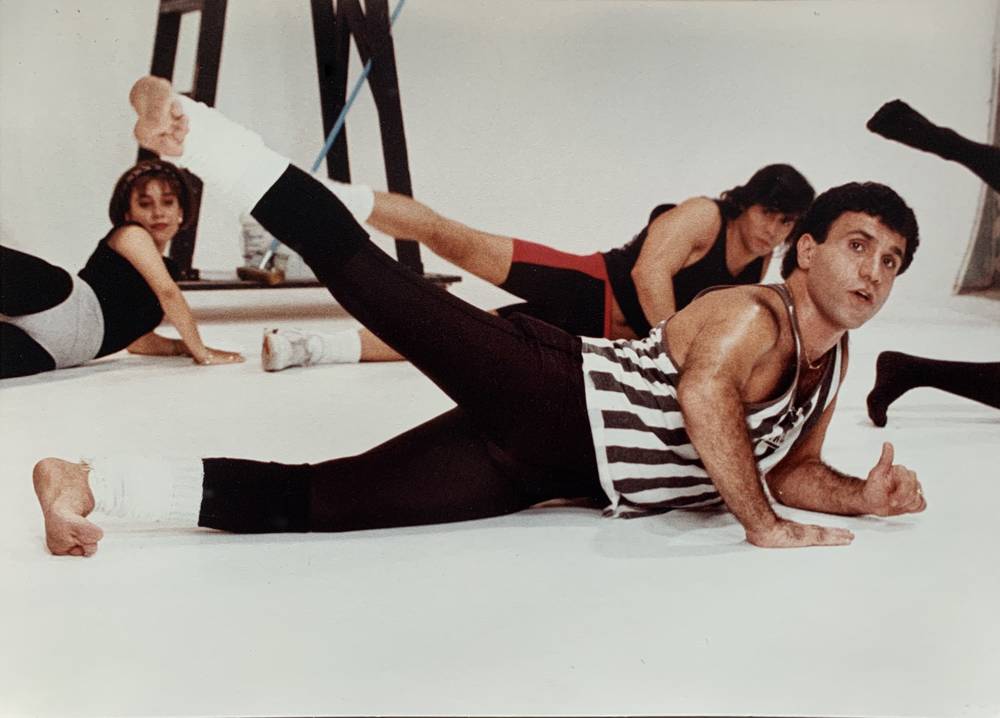
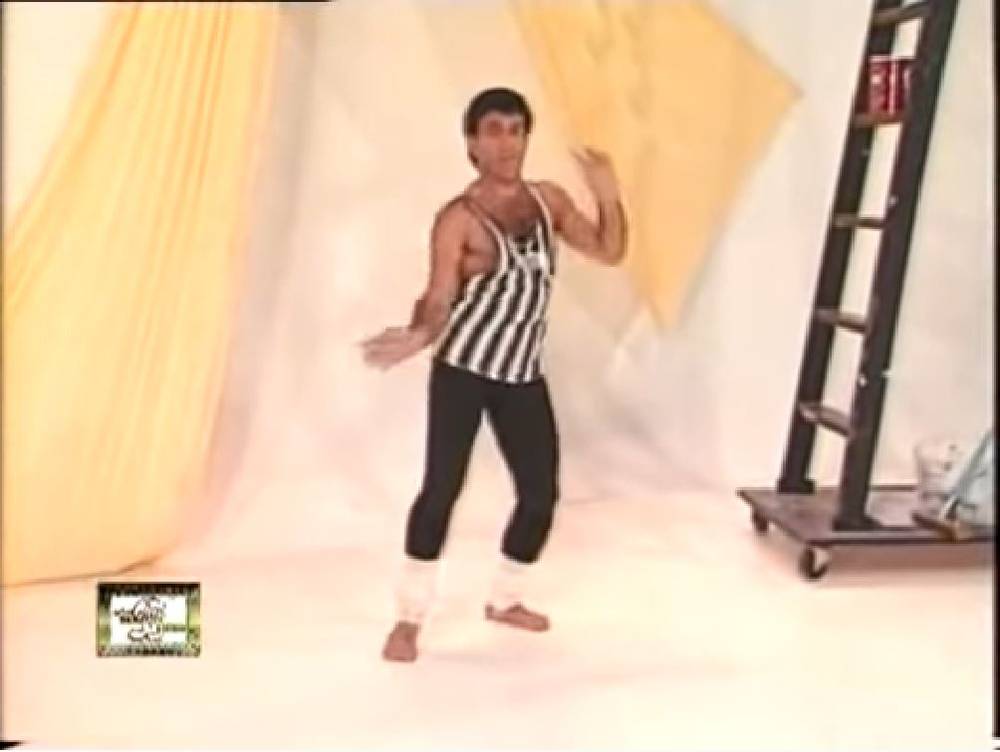
It’s okay not to know what they are, and just to enjoy the cognitive roller coaster ride [...]
One of the pleasures of this exhibition is the gleefully encyclopedic way the artists recombine aesthetic traditions from European modernism, popular culture, historical movements in Persian and Islamic visual culture, and personal symbology. It’s okay not to know what they are, and just to enjoy the cognitive roller coaster ride, experiencing proliferating colors and forms, trying to read what might or might not be symbolic. But these traditions include the abundant practices developed in religious art, such as illuminated Qu’rans and mosque architecture, to celebrate and dignify their subject without depicting figurative images: calligraphic, floral, and geometric ornament, abstractions that point to the divine without representing it.
From the floor painting, “O You People!”, fascinating clusters of figures peep out from exuberant, spasmodic swoops of paint, some created with the artists’ hilarious painting robot, the so-called Dastgah. Parts of the painting are covered with vortical patterns of dark and light triangles, like the hallucinatory op-art of Vasarely—and also a budget version of mirrored muqarnas, architectural ornaments covered with small mirrors that send coruscating light, in Shi‘i religious architecture and palatial residences. Populations of little figures swim and mingle among the abstract motifs, as though someone stirred the whole painting with a giant spoon. Decorative cartouches in the form of Shamseh—employed in manuscript illumination to frame an important, usually religious, text—become a pillowy container for naked lovers embracing, bathers, and people texting, their heads modestly obscured. With this swap of body for text, the artists place the human where the divine word used to go, deftly inverting the religious hierarchy.
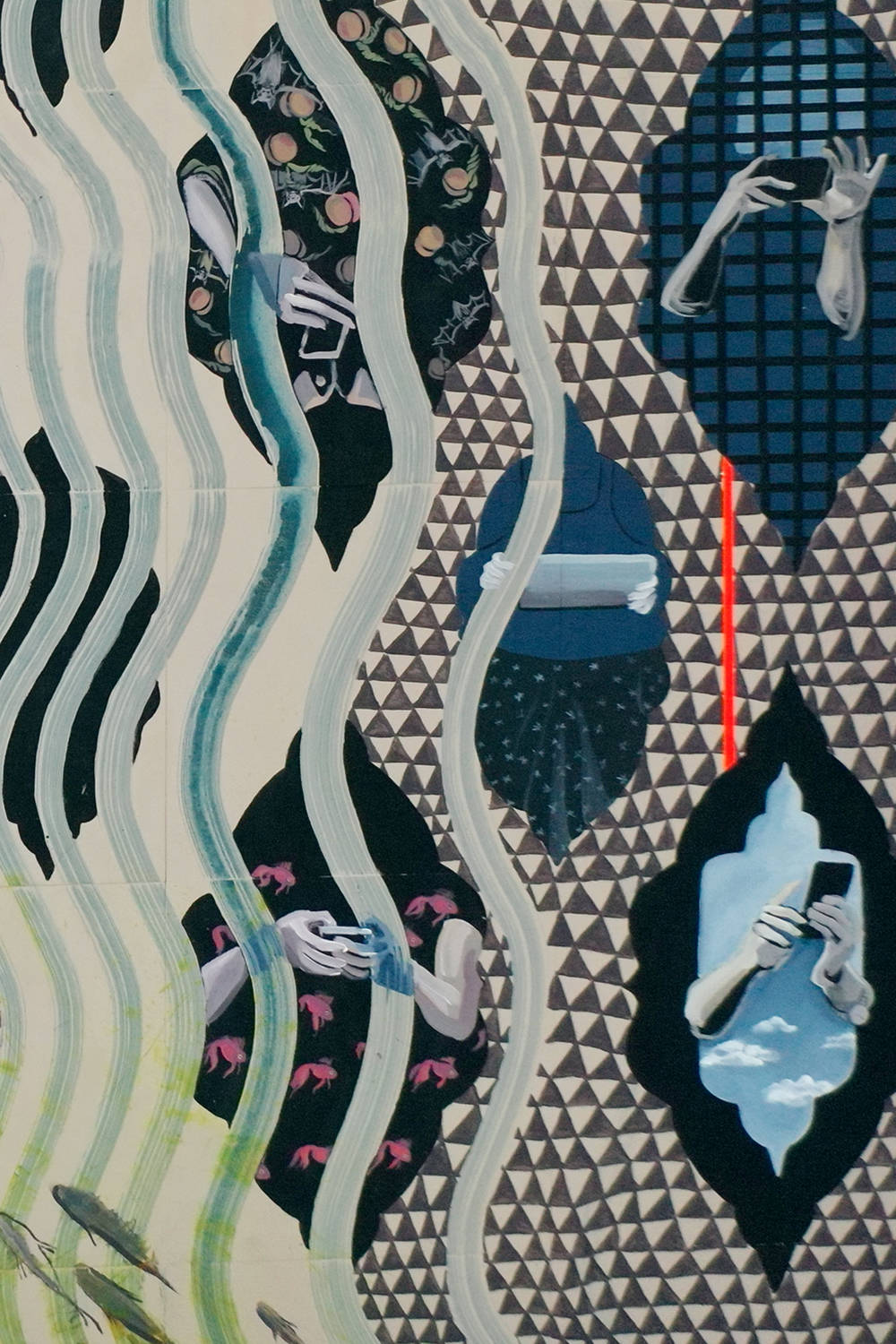
Donkeys are everywhere. A pretty blue and turquoise vignette of donkeys tapping on laptops, watching videos of other donkeys. Grumpy donkey-headed people queuing in line. Braying donkey heads with screaming human mouths. The painterly, distorted creatures seem a hybrid of Francis Bacon, nightmarish figures from Persian astrology manuals, and the scary alien in the movie Alien. In Persian tradition, donkeys are bad omens, or evil, but also apotropaic, protecting one from evil, and donkey talismans are popular. The artists seem to identify with this figure that is rejected yet necessary, like the position of gay men in the Islamic Republic.
The omnipresent donkeys are not only regarded as bad omens
For centuries, Islamic bowls and basins of metal and ceramic were decorated with symbols of the heavens and signs of the zodiac. Holding one would be like holding the cosmos in your hands, or looking up into the dome of a mosque, which could also suggest a complex, beautifully organized universe. Beginning in the 10th century in majority-Shi‘i eastern Iran and Fatimid Cairo, these symbols included a long-eared hare at the center or a circle of swimming fish, signifying sun, stars, and the movement of the heavens.
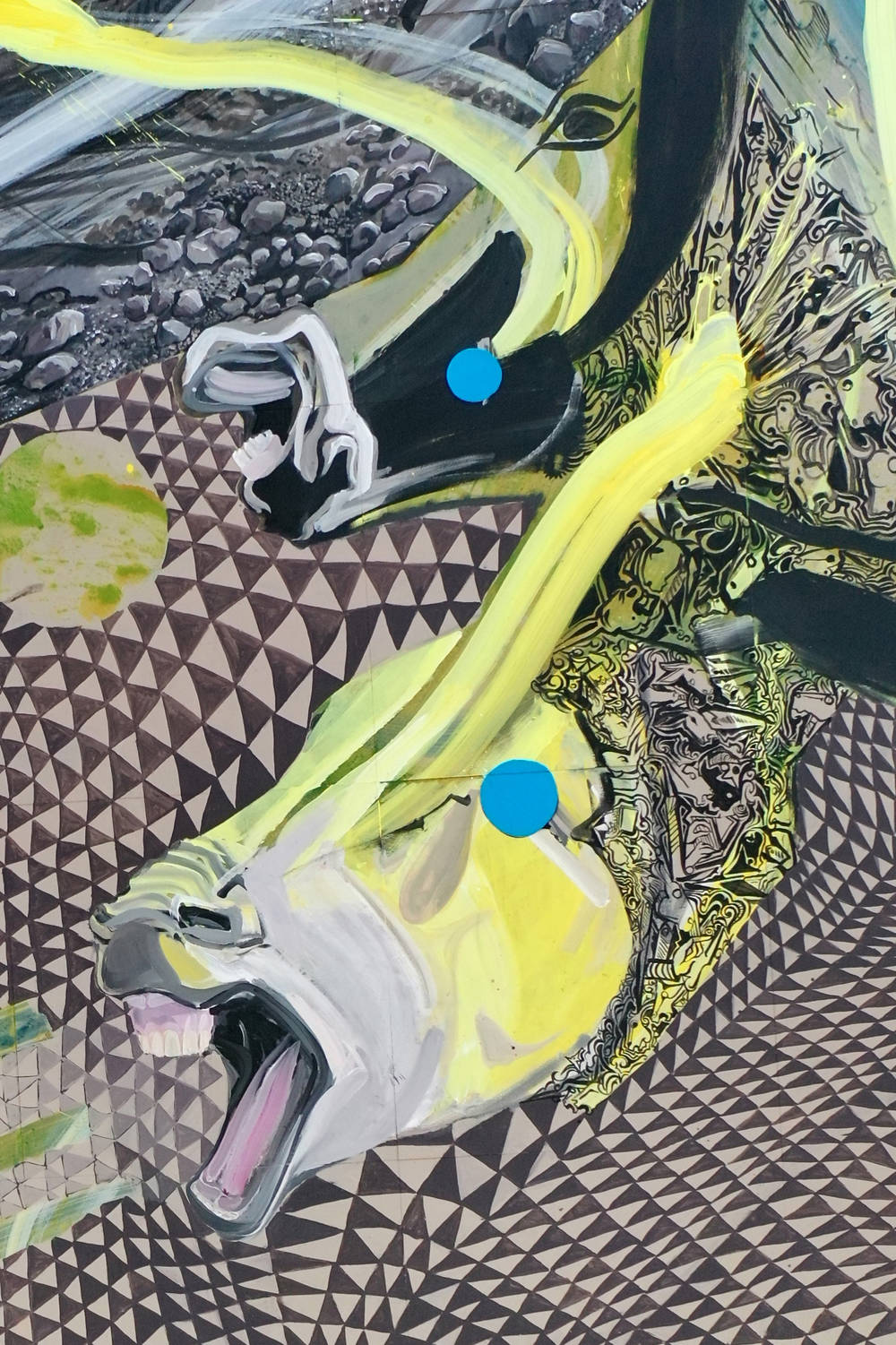
But what do we see at their cosmic center? Not a sign of the divine, the cause of all things, but pretty pink buttholes!
One of my favorite symbols in “Oh you people!”, the concentric blue circles with sardine-like carp swimming around, recalls this cosmos in miniature. But what do we see at their cosmic center? Not a sign of the divine, the cause of all things, but pretty pink buttholes! The whole floor starts to look like a painting of the universe itself: not the well-organized, God-centered universe of religion but the dynamic, messy, open-ended universe of this world.
To make their “moving paintings,” RRH collage news video with archival footage and then print out the frames and paint on them. Re-animated, the movie seethes with painterly artifacts. Sometimes they use a mirror effect as a surrealist technique that will turn a head faceless, open up strange orifices, and birth the monsters latent in the image. The results are movies that are more true, and more terrifying, than the news videos, because they draw ancient patterns and powers into the thin present of current events.
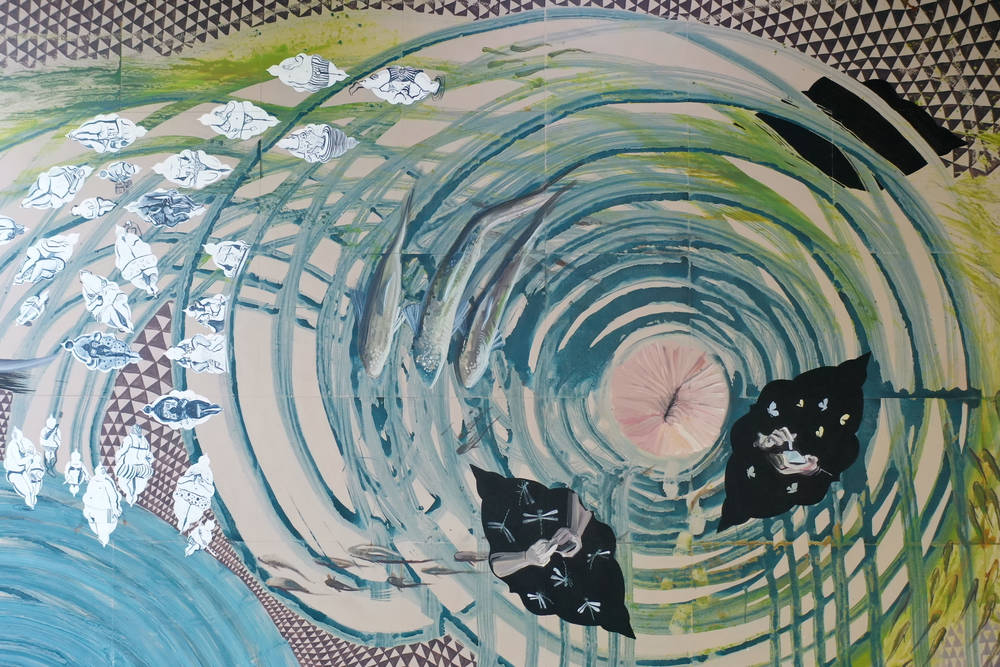
This is especially the case with “If I Had Two Paths I Would Choose The Third”, which turns footage of the fall of Baghdad on April 3, 2003 into an ancient, bestial carnival. As American soldiers topple Saddam Hussein’s statue, the painted crowd bulges and throbs, its faces become monsters, crows, donkeys, giant eyes. Then most terrifyingly, a shot of the American soldiers covering the statue’s face with an American flag is mirrored, and the artists turn the negative space thus created into a gaping mouth, then a vengeful horned creature—the ancient demon awaken by this disastrous invasion.
As Saddam’s statue falls, roses rise from it on slim stems and the cosmic symbol of a hare grows in its belly; as though to mourn or redeem Iraq’s military dictator. A man beating someone with a shoe is transformed into a screaming red-eyed rat. A donkey, beast of reason in Haerizadeh, Haerizadeh and Rahmanian’s symbology, brays above the heads of the crowd.
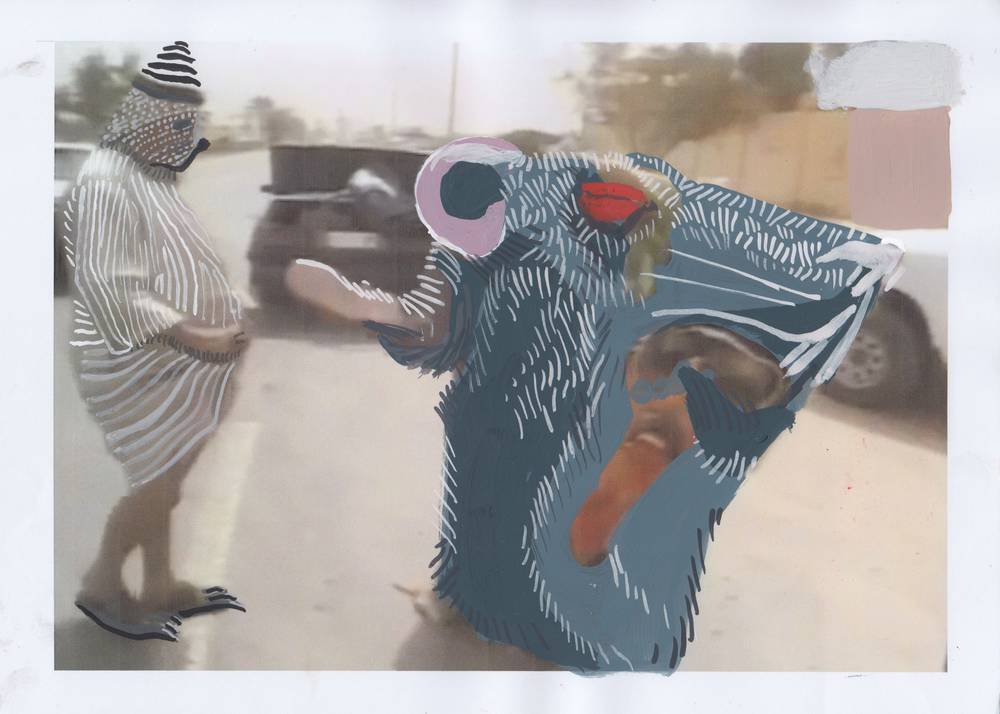
Dotted in the space are lovingly handcrafted sculptures, whose many artisans the artists acknowledge gratefully. I particularly love “Memories Well Up from the Heart and Draw a Curtain on the Eye”, a precarious waterwork of airborne objects. Suspended in arcs of copper tubing hang long ceramic lettuces; below them, douches rendered in white porcelain stream water into a colorful, beat-up metal bowl. Maybe it’s just me, but their shapes evoke, respectively, testicles and spermatozoa, and the whole thing seems to graft the Persian tradition of soothing fountains with the permanently frustrated sexuality of Marcel Duchamp’s “Large Glass”, aka “The Bride Stripped Bare by Her Bachelors, Even”. It is joyously perverted and sweet.
“From March to April…2020” allows us to see how the artists create their moving paintings, and also their paintings in the progress on ceramic plates. In these, each a complex artwork in itself, pictures from the news are reframed with traditional ceramic motifs, such as floral and calligraphic borders, and the modern medium of the souvenir plate. The chandelier-like welded sculpture “Alluvium” is an act of grieving for the precious lives deemed less important—society’s silt, or alluvium—in the first months of our current pandemic. Baby birds scream hungrily around the base of a bowl decorated with lush peonies. The topmost plate reads, “not a single leaf is left over my heart to be peeled off. everything is expendable.” At Chennai airport, health workers wearing gloves and plastic gowns await Indian workers thrown out of Dubai: the artists cloak their masked faces in a long-tailed fish.
not a single leaf is left over my heart to be peeled off. everything is expendable.
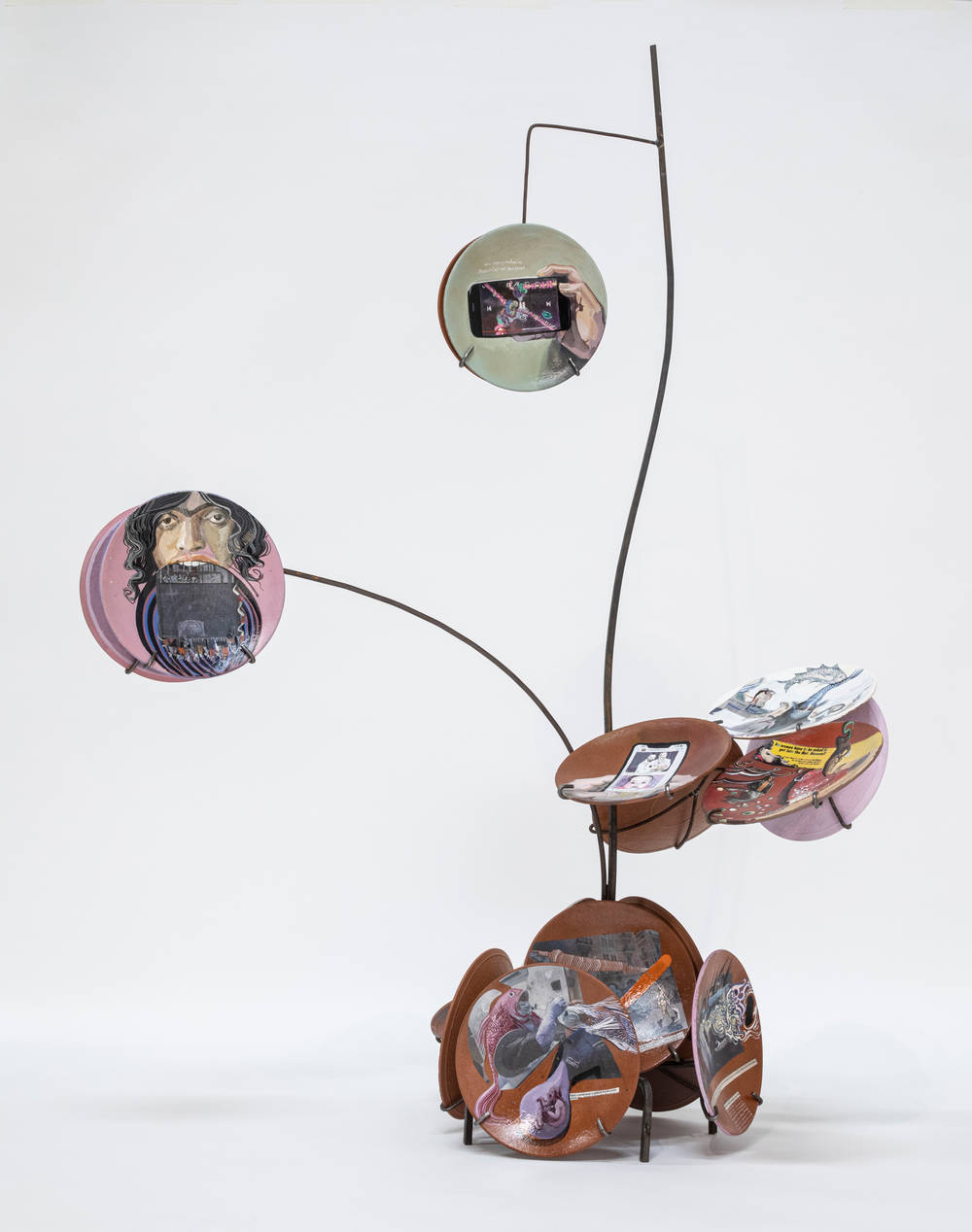
I am terribly moved by an altered photograph of a sanitation-clad worker in Abu Dhabi wheeling a goat to the slaughterhouse. The worker’s feet have metamorphosed into dainty hooves, while the cart from which the hapless goat peers has had its wheels replaced by pale feet in high-heeled shoes. The artists similarly extend kindliness and compassion to heartbreaking news footage of Mediterranean boat refugees, in “From Sea to Dawn”. The painters disguise the migrants’ faces with ladybug wings and fill the survivors’ bodies with the kind of patterns that fill so-called “negative space” on ceramics. Such ornamentation acknowledges that the refugees are “positive space” while maintaining their privacy. It renders these tragically well-known images strange. So that the viewer’s heart can feel for them again.
The tragic pictures experience an alienation
The poor people’s muqarnas pattern I mentioned above engulfs “We Are the Eighth of a Kind”, which documents the trio’s healing performance with Lonnie Holley, artist and raspy-voiced musician from Birmingham, Alabama. The artist trio embodies several personae: a limping, donkey-headed person, an abusive crow, and chubby pigs on all fours.
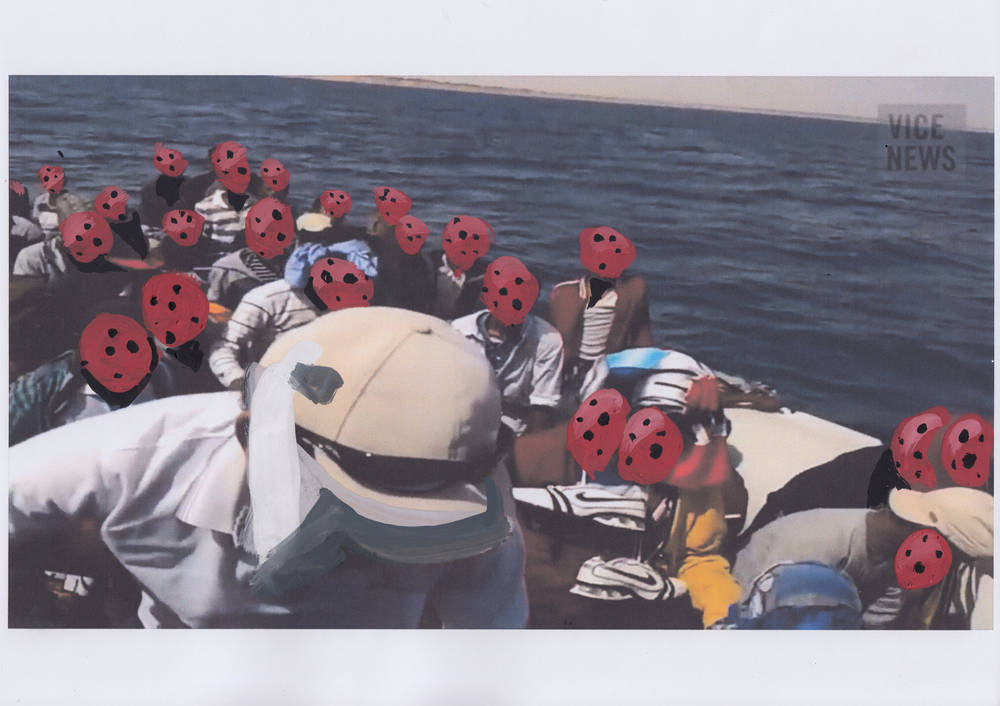
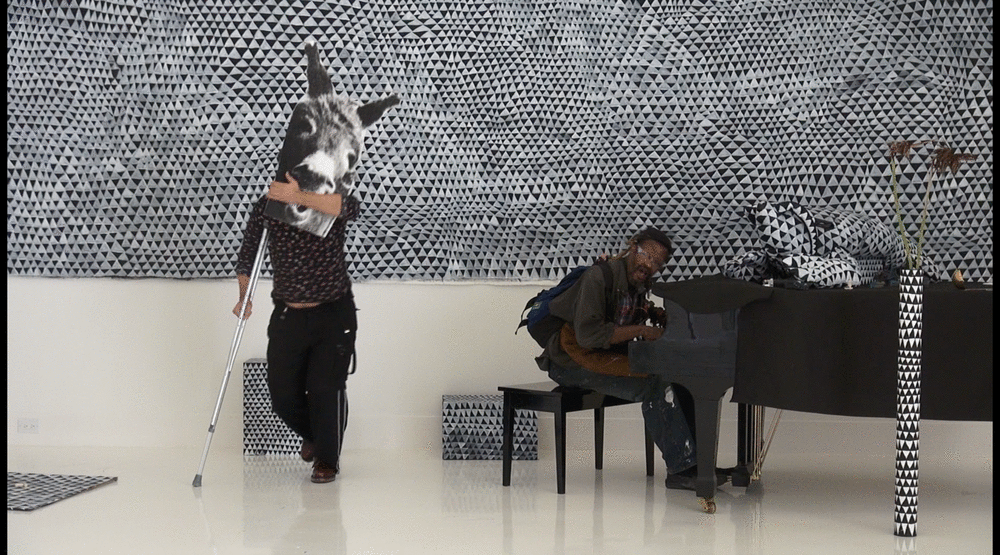
Holley, improvising virtuosically from the piano, weaves a blanket of surprising solidarity between these rejects from Iran and African Americans beaten down by systemic racism. He builds a string of puns around the other English word for donkey—“You broke that ass, you broke that ass”—and sings scat to draw out the shitty connotations of the pigs’ snuffling in the dirt: “Doo doo doo doo doo,” finally inviting the pathetic creatures to cuddle at his knees. To me this work summarizes the force that traverse the artists’ oeuvre and give it so much power. Preferring the intimacy of a few to the cruel judgments of a social order, they create a flourishing private utopia that turns abjection inside out, to release a seemingly endless supply of pleasure and invention. Living well is the best revenge.
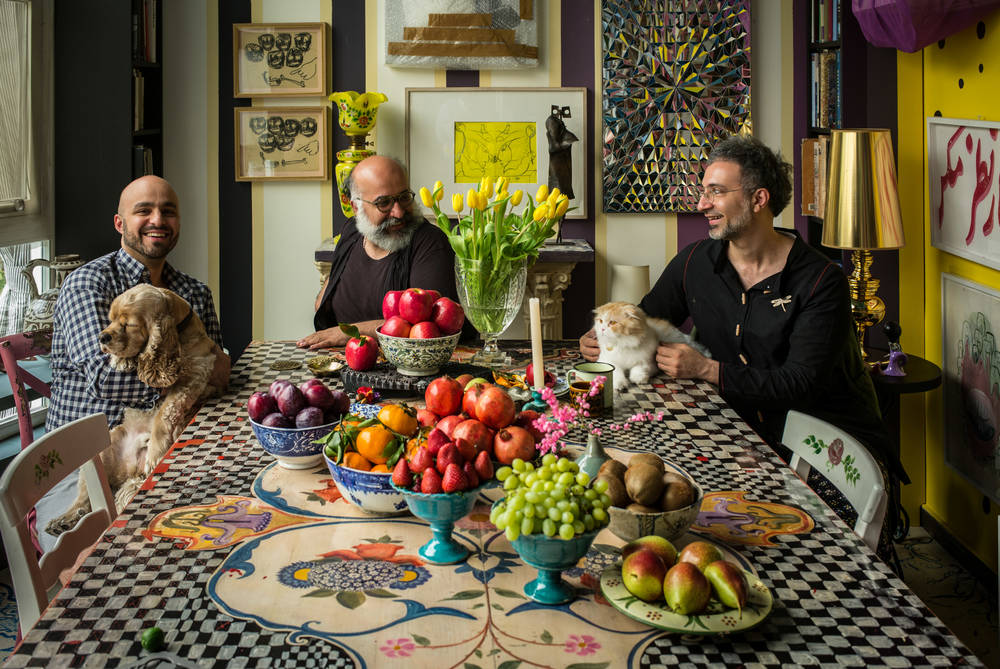
UPDATE
The SCHIRN will be closed from November 2 to 30. We’ll be there for you online – with exciting articles on SCHIRN MAG and lots of content on Facebook, Instagram & Co.









